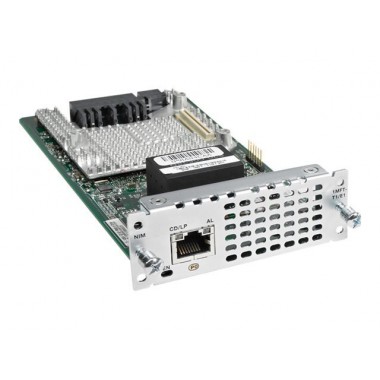1-Port Multiflex Trunk Voice/Clear Channel Data T1/E1 Module
Basic T1/E1 data: The MFT versions act as WICs, supporting T1, fractional T1, E1, and fractional E1. To simplify remote management, these modules integrate a fully managed DSU/CSU for T1 deployments and a fully managed DSU for E1 deployments.
E1/G.703 data: In addition to the basic T1/E1 data support, the CE1T1 versions also support structured G.703 with G.704 framing and unstructured E1 (G.703) applications.
T1/E1 packet voice: All the modules support packet voice applications by providing T1, fractional T1, E1, and fractional E1 connections to private branch exchanges (PBXs) and central offices, thereby enabling new services and reducing voice and fax toll charges. An additional onboard PVDM4 is required. Also, each NIM has its own PVDM4, so each module can be connected to a different service provider with no single clock domain restriction.
Mixed data and packet voice: All the modules can simultaneously support both data and voice, reducing the complexity and number of network components and facilitating a graceful migration to bandwidth-efficient packet voice.
Mixed data and packet voice with drop and insert: You can deploy all the modules as T1/E1 drop-and-insert multiplexers with integrated DSUs/CSUs, reducing the complexity of the network and the cost of the central-office ports by efficiently combining time-division multiplexing (TDM) voice (PBX), IP voice, and data on the same trunks.
E1/G.703 data: In addition to the basic T1/E1 data support, the CE1T1 versions also support structured G.703 with G.704 framing and unstructured E1 (G.703) applications.
T1/E1 packet voice: All the modules support packet voice applications by providing T1, fractional T1, E1, and fractional E1 connections to private branch exchanges (PBXs) and central offices, thereby enabling new services and reducing voice and fax toll charges. An additional onboard PVDM4 is required. Also, each NIM has its own PVDM4, so each module can be connected to a different service provider with no single clock domain restriction.
Mixed data and packet voice: All the modules can simultaneously support both data and voice, reducing the complexity and number of network components and facilitating a graceful migration to bandwidth-efficient packet voice.
Mixed data and packet voice with drop and insert: You can deploy all the modules as T1/E1 drop-and-insert multiplexers with integrated DSUs/CSUs, reducing the complexity of the network and the cost of the central-office ports by efficiently combining time-division multiplexing (TDM) voice (PBX), IP voice, and data on the same trunks.
